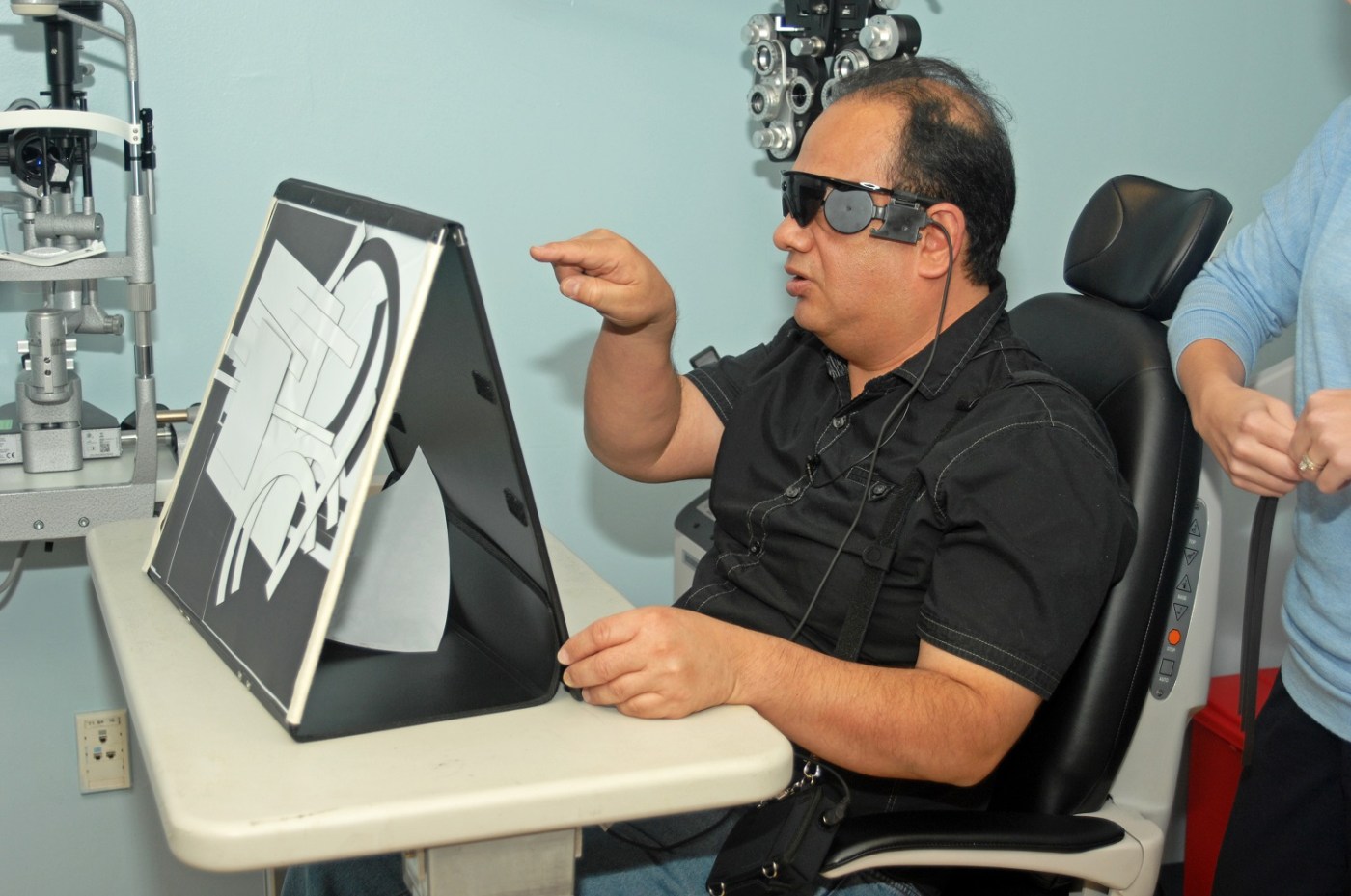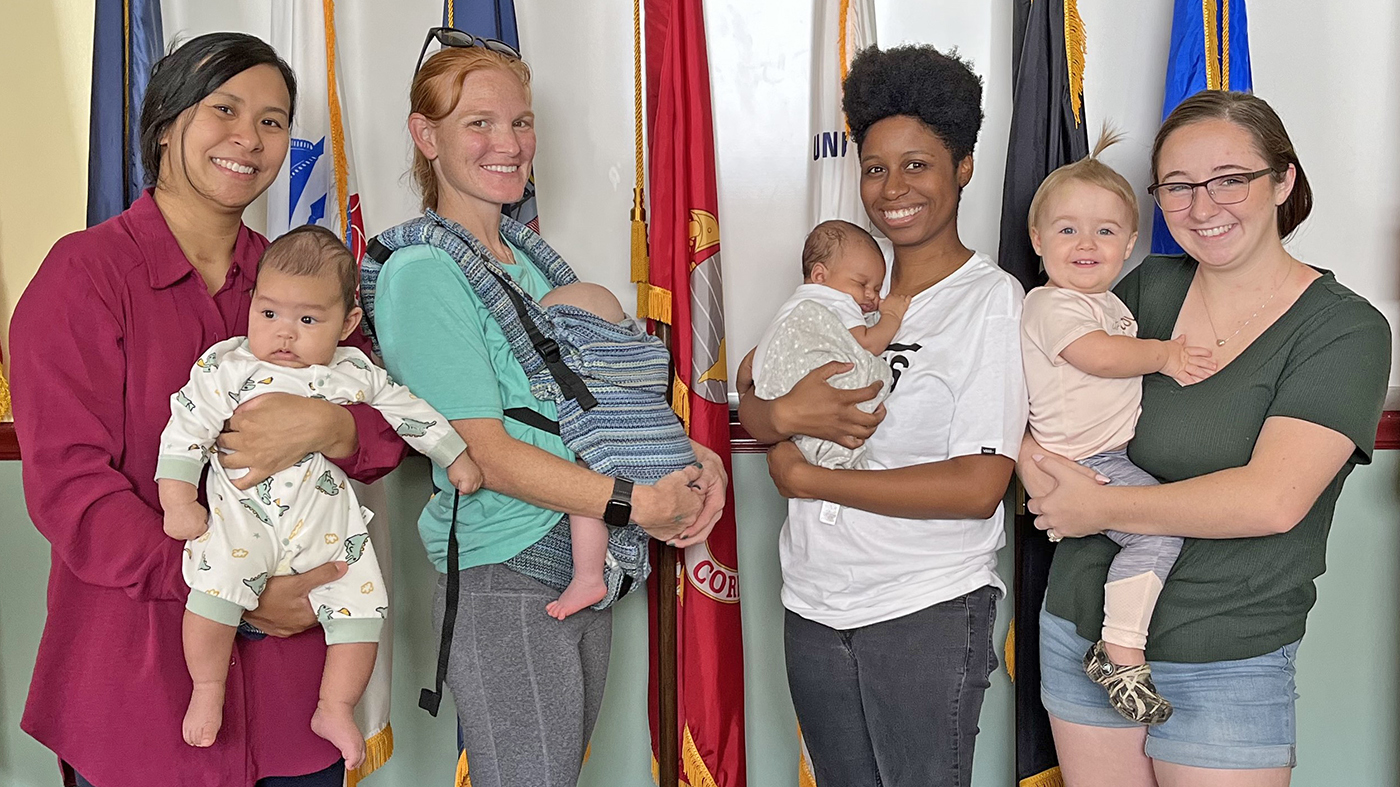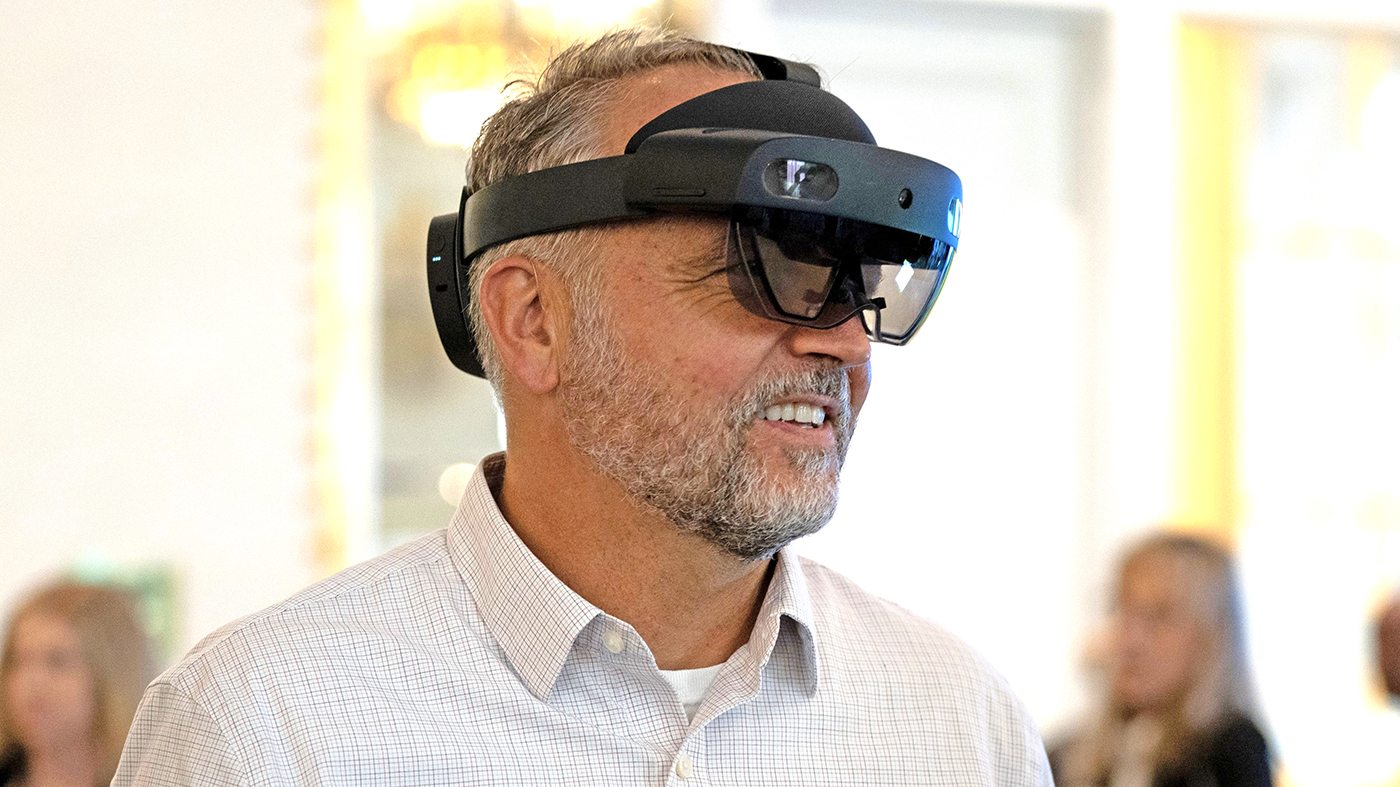The moment Otto Catalan had waited almost two decades for had finally arrived. Sitting in a small office, surrounded by his doctors and other medical staff, the blind U.S. Navy Veteran could only hope for one thing: to see the face of his teenage son for the first time.
“I see a lot of flashes, and they’re getting brighter,” he said. “Wow. It’s amazing.”
He turned his head to the right and saw bright flashes of light reflecting off the white coat of Miami VA Chief of Ophthalmology Dr. Ninel Gregori. When he turned to the left to talk with his son, he paused and began to cry. Gregori hugged him.
“Thank you very much, guys,” he said. “I’ll work hard, so I can see. It’s been 19 years, and I have been able to see my son. Thank you. Thank you so much.”

“I’m learning something new everyday,” he said. “This prosthetic will help me be more successful in life. It’s already helping me be more mobile at home, and it’s going to make a big difference for me at work.”
Catalan’s struggles with vision loss began in 1989, when he was serving as a ship serviceman in the U.S. Navy. While he was on guard duty aboard a ship in the middle of the Persian Gulf, everything suddenly went dark.
“It felt like I was walking in the dark,” he said. “I told my superior officer, and he sent me to a doctor, but they couldn’t find out what it was. We went back to Virginia. They did extensive tests, and that’s when they found out I had retinitis pigmentosa.”
Catalan was scared when he heard the diagnosis. He never heard of retinitis pigmentosa and didn’t know what it would mean for his future. He was immediately removed from the ship and sent to rehab, and would eventually be medically separated from the military.
What is retinitis pigmentosa?
“Retinitis pigmentosa is one of the most common inherited diseases we see in ophthalmology,” Gregori said. “For people with this condition and certainly in Mr. Catalan’s case, the retina becomes very thin, and the photoreceptors, which convert light into electrical signals, gradually die off over time. Initially, peripheral vision, or the side vision, goes away, and then finally the central vision disappears.”
In 2014, the National Eye Institute generally estimated that the rare disorder affected roughly 1 in 4,000 people in the U.S. and worldwide.** This genetic condition results from a mutation in more than 100 genes and can present in individuals without family history of the disorder. It usually develops gradually either early or later in life and eventually causes significant visual impairment, according to Gregori. In severe cases, the disorder can cause a complete loss of vision, forcing people like Catalan to find ways to cope and emotionally adjust to life with the condition.
“I remember crying all the time”
Catalan’s eyesight continued to deteriorate. Still needing to make money, he took a job as a cook. As his conditioned worsened, he struggled to tell if food was cooked and even burned himself multiple times. It was at this point that Catalan knew he needed help, so he went to the Northport VA Medical Center in New York.
“My doctors told me I needed to start preparing because I was going to be permanently blind soon,” he said. “After I heard that, I remember crying all the time. I couldn’t even hear someone say the word ‘see’ because I would burst into tears.”
The Northport VAMC referred Catalan to the VA Connecticut Healthcare System to participate in its Eastern Blind Rehabilitation Service’s three-month training program. While sitting through the training sessions and listening to the instructors and other Veterans, Catalan unexpectedly learned a valuable life lesson.
“Once I met other blind Vietnam Veterans at VA Connecticut and saw how well they were dealing with their situation, I never cried about my own condition again,” he said.
Throughout the program, he also learned to perform everyday tasks, such as shave his face, eat with utensils, identify clothing and walk with a cane. He stayed an additional two months to learn to use a computer and screen-reader technology.
Moving to Florida
In 2005, Catalan heard about ophthalmology research being conducted at the Miami VA Healthcare System and the Bascom Palmer Eye Institute, which serves as the ophthalmology department of the University of Miami Health System. He moved his family to Cutler Bay, Florida and transferred his care to the then Miami VA Medical Center—where he worked with Roberta Goldstein, now retired Miami VA visual impairment services team coordinator.
“Roberta was great,” he said. “She referred me to the prosthetics department at the West Palm Beach VAMC, so I could get equipment to help me go back to work. She’s the best.”
Shortly after receiving his prosthetics equipment, Catalan landed a job as a resource specialist with Marriott Hotels—where he still works today. He says Marriott has been accommodating to his condition, and he hopes to be considered for promotion one day.
In March 2015, he received a phone call that would help his chances of getting that long-awaited promotion and also change his life.
“One of my hopes was to see my son’s face for the first time”
When he heard about the “bionic eye,” Catalan requested an evaluation for the device at the Miami VA Eye Clinic. With the help of the low vision Miami VA team, Gregori selected him for the Argus II® screening evaluation and personally called his home to ask if he was still interested.
“He was a perfect candidate,” Gregori said. “His personality was extremely important. With artificial vision, the patient must have the patience to learn to interpret the lights and images he or she is seeing. Learning to use the Argus II is like learning a new language, so individuals with both an optimistic personality and a strong willingness to work hard are the best candidates for the technology.”
Dr. Gregori is the Miami VA chief of ophthalmology and an associate professor of clinical ophthalmology at the Bascom Palmer Eye Institute. In 2004, she was part of the surgical team that implanted the first Argus II® retinal prosthesis in a Florida patient, a non-Veteran from Tampa. She was eager to bring the new technology to the Miami VA, where she proudly serves South Florida Veterans and has lead the ophthalmology department for the past 10 years.
“Miami VA Medical Center Director Paul Russo and Chief of Surgery Dr. Seth Spector both enthusiastically welcomed the idea of making the bionic eye available to our Veterans. It would not have been possible without their support,” Gregori said.
“It felt like I had just given somebody the best Christmas present”
Catalan underwent surgery to implant the Argus® II, a new prosthesis approved in 2013 by the Food and Drug Administration to treat people with end-stages of retinitis pigmentosa, at the Bascom Palmer Eye Institute on Nov. 24, 2015. Catalan’s bionic eye was activated Dec. 11 by the Bascom Palmer Eye Institute’s biomedical engineers, under the supervision of Miami VA’s Dr. Ninel Gregori. Even though Gregori and her team had already been through the experience of turning on the prosthesis with a previous patient, Catalan’s moment was emotional nonetheless.
“When it was turned on, Mr. Catalan started crying, and it brought tears to my eyes,” Gregori said. “It felt like I just gave somebody the best Christmas present I had ever given to anybody in my life. That’s why I went into ophthalmology.”
“After 19 years, the first thing I saw was my son’s face,” Catalan said. “I could also see Dr. Gregori, and when we walked around the hall, I was able to tell where the door and window frames were for the first time. That might not mean a lot to other people, but it meant so much to me.”
Catalan’s progress
Catalan continues to work with the Miami VA Blind Rehabilitation Team, lead by optometrist Dr. Kasey Zann, to learn how to use the Argus II® in his everyday life. Blind Rehabilitation Outpatient Specialist Linh Pham visits his home and trains him to use the device in his home environment and in public. He also works regularly with Gregori and her team at the Miami VA Eye Clinic.
“The Miami VA Healthcare System has amazing low vision and blind rehabilitation resources for Veterans. It is an ideal setting for rehabilitation after Argus II implantation,” Gregori said.

During an outing with his family in early 2015, Catalan was surprised to see a sight he had not seen in years.
“On New Year’s Eve, I was able to see the fireworks outside for the first time in 19 years. My mouth stayed open for a while,” he said. “Now, when I’m walking on the grass, I can see the lines where the grass is versus where the sidewalk is. The fact that I’m walking outside and can see the lights makes it all worth it.”
About the Argus® II Retinal Prosthesis System
The Argus® II Retinal Prosthesis System—made by Second Sight Medical Products, Inc.—is an artificial retina, or bionic eye, that converts images into light and uses a miniature video camera that is mounted on a pair of glasses, said Gregori. Once the images are converted, they are wirelessly transmitted to a surgically implanted prosthesis located in the patient’s eye. The implant then stimulates the retina to produce an image that is sent to the brain for interpretation.
According to the Second Sight website, more than 200 patients worldwide have now received the prosthesis. To learn more about the Argus II, visit the Second Sight Medical Products Inc. website.
About the author: Jason Dominguez is a public affairs specialist at the Miami VA Healthcare System. He is an Army Veteran who served in Operation Iraqi Freedom from 2004 to 2005.
About the video producer: Adam Poitras is a visual information specialist at the Miami VA Healthcare System. He is an Army Veteran who served in Operation Iraqi Freedom from 2004 to 2005.
Topics in this story
More Stories
Perinatal Veterans Socials bring together new parents to build social connection as they navigate parenthood and post-partum care.
Veteran Eric Golnick joined the Million Veteran Program after losing his best friend to cancer caused by toxic exposure.
Barry Peterson shares his experience as a VA virtual reality provider and user and how it helps him connect with other Veterans.








This is a FAN-TAS-TIC Story! As a Veteran myself, it both elates and saddens me.
I am elated that such a fantastic device could even exist and be able to be used in humans! This has to be the best thing since sex, and even more gratifying. Pure ecstasy for some. I’m also fairly sure that in the future this technology can be used for much more than the retinitis pigmentosa patients.
Since I have a college buddy with the disease I am saddened however that a small amount of research showed me that people like my friend, not a Vet, currently have no access to it. I just wish it could be made available to all whom the prosthetic could help, but that may be years away, even decades away yet.
In addition to that, I am really saddened that the VA cannot yet control its own staff and offices in order to eliminate backlogs of patients and the extremely long waits before a Vet can get attention. Overall, their abysmal attitudes and idiots in charge of offices et al, is a sorry record for such a service-oriented organization. There are very few offices that can claim an actual, near total success in fixing those problems, and yet the problems just continue.
All the above paragraph makes the test results for the prosthetic eye nearly negligible in light of the lousy access Vets have to even knowing about such great successes.
Just think how much it would mean to ALL veterans, even those like me who served in Viet Nam and others in the Korean “Police Action” etc. etc. etc..
This news deserves to be all over the news media with an unbiased, detailed description so those who need it can at least know that it exists.
What an outstanding achievement by all.
This is an amazing story.
I salute you all!
I sure hope this eye dr can make it work for 1 eye only
Best wishes for this brave person, Hope early his life will be alright like before, . Thank you for share this with us.
So happy for this Veteran.